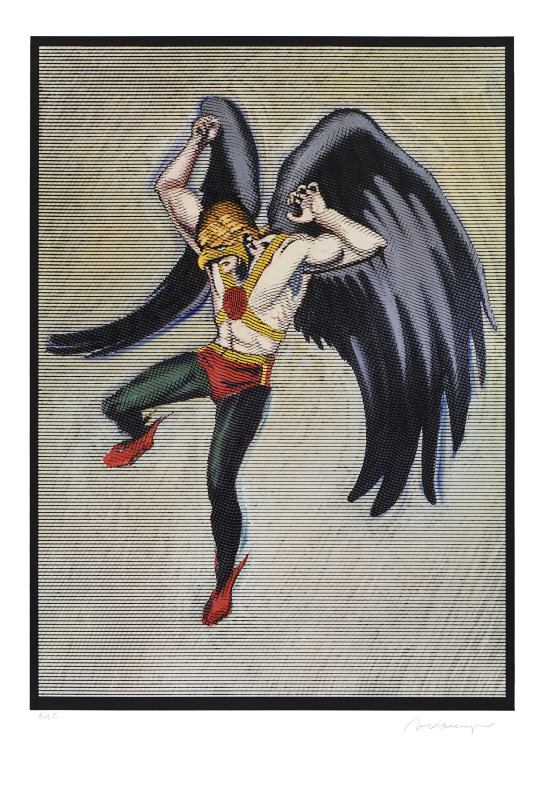
woodcut with acrylic
image: 37 x 26.75 in. paper: 44 x 30 in.
edition of 30
Following the Mel Ramos retrospective that traveled across seven major European museums in 2010-2011 to celebrate Ramos’s 75th birthday it seems only fitting that Magnolia Editions revisit the iconic superhero paintings that would catalyze Ramos’s emergence as one of Pop Art’s most recognizable figures.
Ramos’s work often includes playful nods to art history, and he imparts a subtle classicism to this print via Hawkman’s bird-shaped mask, recalling Hieronymous Bosch’s bird-headed figures, and winged slippers harkening back to the Greek god Mercury (Hermes). Hawkman is also the most dynamic of Ramos’s superhero prints to date, as its protagonist hangs suspended in mid-flight – a muscular, colorful seraphim for the postmodern age.
As curator Louis K. Meisel writes, “In mid-1961, at the beginning of what would be called ‘Pop Art,’ Mel Ramos produced what we would consider his first true mature image. That very well-known painting is Superman, and it displays a style and technique which Ramos has been identified with ever since. Superman […] was the first true Pop painting that the artist produced. Followed by Batman, these paintings were straight out of the comic books, and in every way related to the commercial images of Andy Warhol, the cartoons of Roy Lichtenstein, and the word paintings of Ed Ruscha, not to mention the few others all hitting stride in 1961 and 1962.”
Today, Ramos has the benefit of decades of printmaking experience and a corresponding knack for getting the most out of his collaborators. The artist worked closely with Magnolia director Donald Farnsworth and Bay Area realist painter and frequent Magnolia collaborator Guy Diehl to develop the wood block matrices and the corresponding layers of acrylic color. Ramos is well known for his color lithograph editions (a 2006 lithograph revisited Superman) but these prints represent an unusual and bold move toward woodcut — a very different print medium and one which Ramos had rarely explored before this project.
Over the course of several months, Farnsworth and Diehl worked with Ramos to digitally translate his compositions into raster files, creating a digital template for a computer- guided laser to carve the basic matrix from a block of wood. Ramos and master printer Nicholas Price then proofed this image in black ink and Ramos used white paint to indicate areas that should be carved further; Diehl, whose own paintings demand an extraordinarily still hand and eye for detail, performed much of the subsequent hand carving. The artist proofed new colors for these editions, which were printed by master printer Tallulah Terryll in UV-cured acrylic ink over a woodcut impression in black relief ink printed by master printer Nicholas Price. Each print is an edition of 30, signed and numbered by the artist and available directly from Magnolia Editions.
Besides signaling the beginning of Pop Art, Ramos’s early superhero paintings — especially Wonder Woman — marked an important transition in the artist’s subject matter. Once the de Kooning-inspired abstractions of his art school days gave way to the unambiguous figuration of the forementioned caped crusaders, it was only a matter of time before Ramos began painting superheroines. The advent of 1962’s Phantom Lady and Wonder Woman ultimately led to the colorful female nudes for which he is best known. As such, Ramos’s new woodblock editions with Magnolia find the artist celebrating how far he has come by using 21st-century printmaking innovations to revisit the paintings that started it all.
–Nick Stone
show prices
Prices and availability are subject to change without notice.The copyright of all art images belongs to the individual artists and Magnolia Editions, Inc.
©2003-2026 Magnolia Editions, Inc. All rights reserved. contact us
